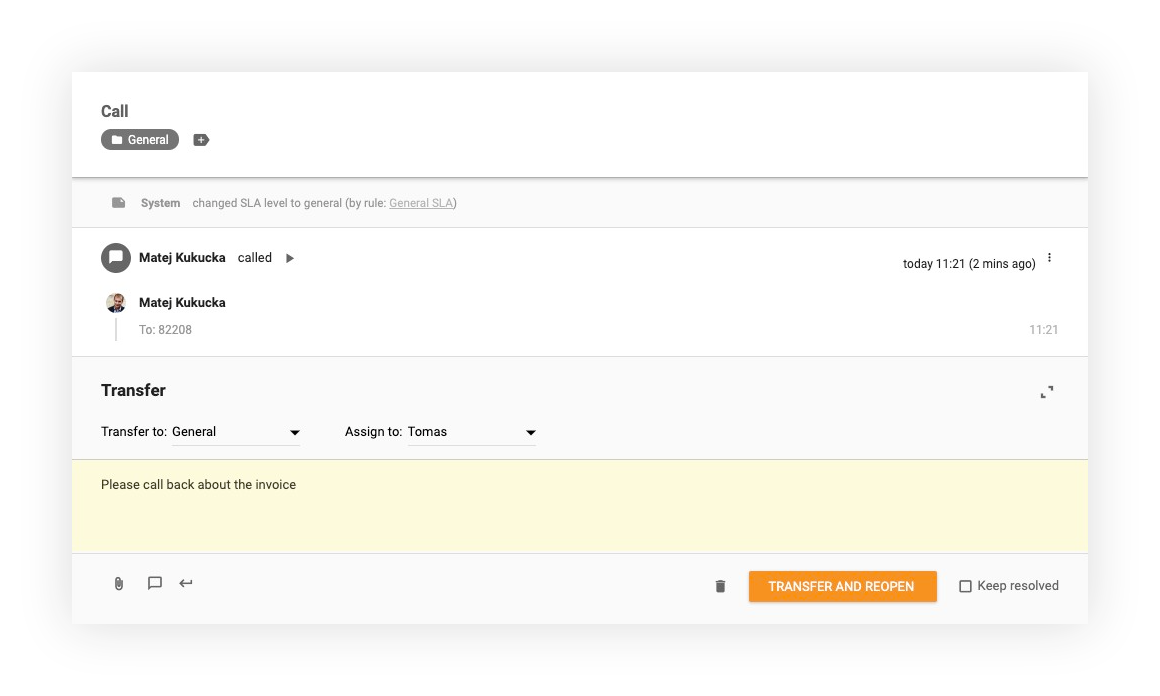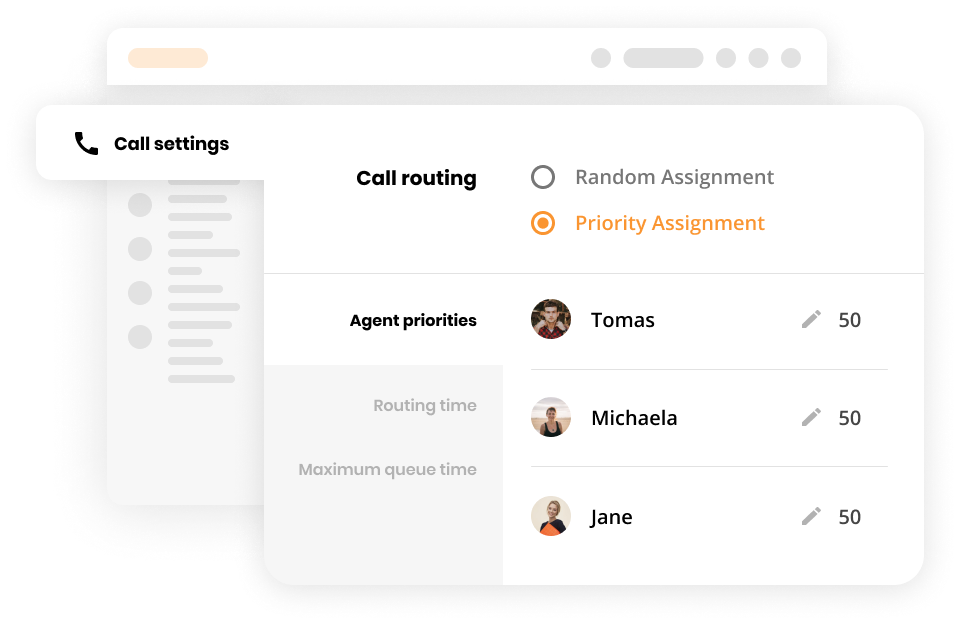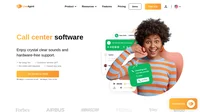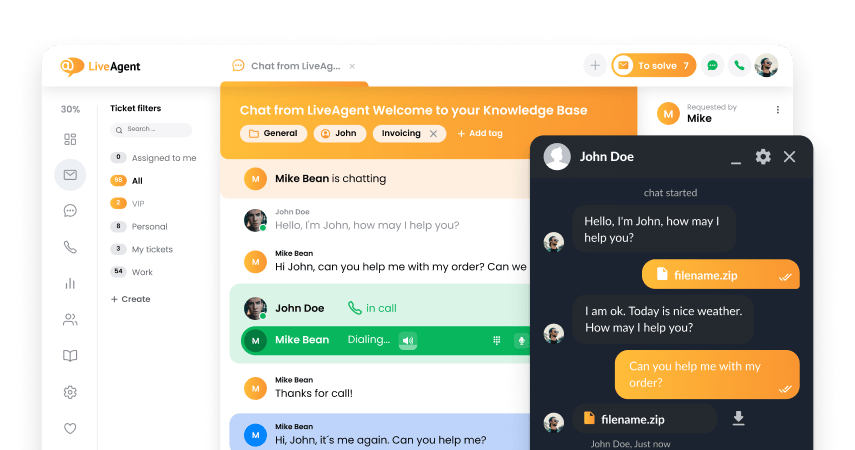What are attended call transfers?
Attended call transfers wait to terminate the call until it’s either picked up, rejected, or not answered by another agent. It simply transfers (bumps) a call from one agent to another. That means your agents don’t have to keep your customers waiting for an unnecessarily long time for a colleague.
Attended transfers take care of this in a much more polite manner than cold transfers, where you and the customer don’t know if the other person will pick up.
Once a customer calls and is about to be transferred by an agent, the call is put on hold. In the meantime, another call is initiated to make sure the end destination can answer. If the call is not picked up, it is returned to the original agent.

Who benefits from attended call transfers?
Transnational corporations, large enterprises, and multi-national businesses with several departments and hundreds of agents all have to transfer calls daily. Many calls might end up in the wrong department or be handled by the wrong agent. This is where the attended call transfers come into play.
Benefits of attended call transfers
Contact with impatient customers
Impatient customers looking for instant answers can now be served in a matter of seconds, even when they call the wrong department or agent.
Agents have time to prepare
While the incoming call is being transferred to another agent, the customer can get additional information from the agent who picked up the call first.
Increase customer happiness
Happy customers are one of the most precious assets any company can have. Improving their happiness with a personalized approach like attended call transfers is worth the effort.
Other beneficial call center features
IVR
Utilize robust Interactive Voice Response (IVR) technology to direct your callers to a specific department or agent. Create unique IVR trees, which can be ready in a matter of minutes. By defining the particular set of options your customers will choose from, uploading a welcome message, or a short snippet of music, you’ll be able to provide a much more personalized customer approach.
Intelligent call routing
An essential part of call center software is call routing, also known as Automatic Call Distribution (ACD), which is a feature that automatically distributes calls to the agents based on the pre-selected requirements. LiveAgent supports call routing based on random assignment or priority assignment. By deploying the random assignment, all incoming calls will be distributed to agents in random order. The priority assignment maximizes the availability of your agents and minimizes the idle-time.

Test attended call transfers for free
Check out how attended call transfers, IVR, and ACD work in practice with our free 30-day trial. No credit card required.
Frequently Asked Questions
What is the transfer rate in a call center?
The transfer rate refers to the percentage of calls that are transferred from one agent/department to another. This can happen for a variety of reasons, such as the initial agent not being able to handle the issue, or the need for specialized assistance from another team. It is an important metric, as it can impact customer satisfaction and operational efficiency. High transfer rates can lead to longer wait times and increased frustration, while low transfer rates can indicate that agents are well-equipped to handle a wide range of issues.
What are the 2 types of transfers in call center?
There are two main types of transfer in a call center. Warm transfer involves connecting the customer with another agent or department while staying on the line to introduce the customer and provide context of the inquiry. Cold transfer is refers to transferring the customer to another agent or department without any context provided by the initial agent. Cold transfers are typically quicker but may result in a disjointed customer experience.
What is the Attended call transfers feature in LiveAgent?
Attended call transfer is a feature in LiveAgent’s call center that allows your agents to connect customers to a different department if needed.
How do Attended call transfers work in LiveAgent?
The attended call transfer feature in LiveAgent is programmed to wait until the call is picked up or rejected by another agent before it is terminated. As a result, the customer does not need to wait an unnecessarily long time. Warm transfers are smoother, more productive, and overall preferred.
How can you benefit from using the Attended call transfers feature in LiveAgent?
The benefits of attended call transfers include increased customer satisfaction, customer loyalty, and improved agent workflow.
LiveAgent monthly updates: April edition
Discover LiveAgent’s April updates: chat fixes, improved ticket sorting, API enhancements & a new HelpDesk migration plugin. Read more!
Provide excellent customer service
Discover unparalleled customer support with LiveAgent's all-in-one software. Benefit from 24/7 service, a free trial without a credit card, and seamless integration across 130+ ticketing features. Enhance your business with fast setup, AI assistance, live chat, and more. Choose LiveAgent for exceptional service and satisfied customers.

 Български
Български  Čeština
Čeština  Dansk
Dansk  Deutsch
Deutsch  Eesti
Eesti  Español
Español  Français
Français  Ελληνικα
Ελληνικα  Hrvatski
Hrvatski  Italiano
Italiano  Latviešu
Latviešu  Lietuviškai
Lietuviškai  Magyar
Magyar  Nederlands
Nederlands  Norsk bokmål
Norsk bokmål  Polski
Polski  Română
Română  Русский
Русский  Slovenčina
Slovenčina  Slovenščina
Slovenščina  简体中文
简体中文  Tagalog
Tagalog  Tiếng Việt
Tiếng Việt  العربية
العربية  Português
Português 





